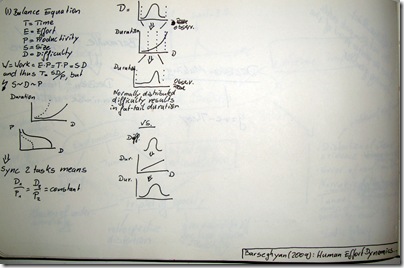Barseghyan, Pavel: Human Effort Dynamics and Schedule Risk Analysis; in: PM World Today, Vol. 11(2009), No. 3.
http://www.pmforum.org/library/papers/2009/PDFs/mar/Human-Effort-Dynamics-and-Schedule-Risk-Analysis.pdf
Barseghyan researched extensively the human dynamics within project work. He has formulated a system of intricate mathematics quite similar to Boyle’s law and the other gas laws. He establishes a simple set of formulas to schedule the work of software developers.
T = Time, E = Effort, P = Productivity, S = Size, and D = Difficulty
Then W = E * P = T * P = S * D, and thus T = S*D/P
But and now it gets tricky S~D~P are correlated!
The author has collected enough data to show the typical curves between Difficulty –> Duration and Difficulty –> Productivity. To schedule and synchronise two tasks the D/P ratio has to be constant between these two tasks.
Barseghyan then continues to explore the details between Difficulty and Duration. He argues that the common notion of bell-shaped distributions is flawed because of the non linear relationship between Difficulty –> Duration [note that his curves have a segment of linearity followed by some exponential part. If the Difficulty bell curve is transformed into the Diffculty–>Duration probability function using that non-linear transformation formula it looses is normality and results in a fat-tail distribution. Therefore Barseghyan argues, the notion of using bell-shaped curves in planning is wrong.

